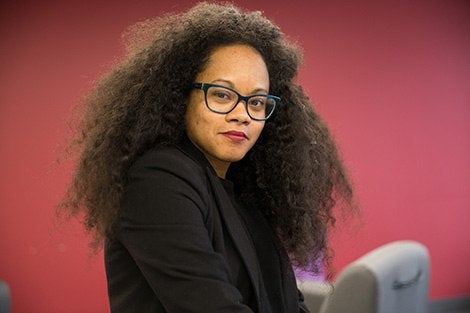Olivia R. Orta, SD ’18, looks at the role that exposure to social toxins, such as violence, plays in health
May 22, 2018 – “In utero, probably,” mused Olivia R. Orta, in response to a question about when she first became interested in science. “I’ve loved science since forever.”
Pinpointing a postnatal moment of actually choosing science, she remembers a time around fourth grade when, for one period a day, the students could “cycle” through a class of their choosing. From among the many options, Orta chose microscopy. In the first class, the teacher instructed the kids to pluck a strand of hair and look at it under a microscope. For Orta, it was a revelation.
“When I looked through the microscope,” Orta said, “it was a spiritual moment. For me, looking through a microscope is like seeing beyond everything.” The next time the students were allowed to cycle through a class, she chose the same one. Little did she know that, years later, strands of hair would figure in her dissertation research.
Seeking a bigger understanding
The only child of proud Nuyoricans (New Yorkers of Puerto Rican descent) from the South Bronx, Orta graduated in 2007 with a bachelor of science degree from John Jay College of Criminal Justice, where she studied forensic science with a concentration in toxicology. Although her toxicology studies focused largely on understanding biochemical processes and laboratory techniques, what she found especially interesting was learning how the human body functions and malfunctions in the presence of toxins. “The way our bodies work and how they stop working is fascinating to me,” she said. But at one point, prompted in part by a documentary about obstetric fistulas—biological malfunctions related to the birthing process—Orta realized that although her training in the body’s biochemical processes was important, it was not enough.
“My transition from bench science to public health came about when I discovered that such malfunctions can happen because of biological reasons, yes, but also because of societal and injustice issues related to health care access,” she said. Working at the time in a microbiology and immunology lab, she realized she needed “a bigger understanding of what’s happening outside of this petri dish.”
‘Numbers, justice, health, science, everything’
In 2011, Orta was accepted to the CUNY School of Public Health to study epidemiology and biostatistics, which combined “numbers, justice, health, science, everything.” “In my first epidemiology class as a master’s student,” she said, “I found what I was supposed to do in life: be an epidemiologist.” She maintained laboratory positions while working toward her master of public health degree, which she earned in 2013.
Orta’s next move was to Harvard Chan School to pursue a doctor of science degree in epidemiology. Attending the School during a time of national turmoil following the police killing of Michael Brown in Ferguson, Missouri, Orta worked alongside a number of other students to help promote discussions about racism within the School. She also served on student advisory committees and as a teaching assistant, presented her work at national conferences, and first-authored four journal articles.
As an epidemiologist, Orta has continued her interest in the long-term ramifications of toxins and their impacts on biological mechanisms. But for her dissertation, she shifted gears to focus specifically on the health impacts of social toxins like violence. She examined whether a history of physical or sexual abuse during childhood was associated with stress-response activity in adulthood. In one cohort, women enrolled in the Pregnancy Outcomes, Maternal and Infant Cohort Study (PrOMIS), she evaluated whether levels of cortisol—a biomarker of stress-response activity—in the hair of pregnant women with a history of childhood abuse differed from the cortisol levels of women without these abuse histories. In a second cohort, women enrolled in Nurses’ Health Study II, she evaluated whether levels of two stress-response biomarkers—cortisol and dehydroepiandrosterone (DHEA)—in the saliva of older postmenopausal women with a history of childhood abuse differed from the levels in comparable women who had not suffered such abuse. To help fund her education at the Harvard Chan School, she received two predoctoral training grants from the National Institutes of Health, one for reproductive perinatal and pediatric epidemiology and one for psychiatric epidemiology.
Overall, Orta’s findings suggest that a history of abuse in childhood affects stress-response levels later in life. Since abnormal stress-response levels are associated with poor health, Orta notes, “child abuse is an important public health issue and a social toxin with long-term health impacts. But it’s also something that societies can change.”
Moving on
Following her graduation in May, Orta will be heading to the Boston University School of Public Health for postdoctoral studies. She plans to continue examining how chemical and social toxins affect health outcomes across the life span. She will take with her a “full epidemiology toolkit” from Harvard Chan School, along with some lifelong treasures—Orta met her husband at the School, made great friends, and developed a wonderful community of “amazing people who will undoubtedly change the world.” She cherishes the connections that she made with mentors and plans to stay in touch with them throughout her career—one that will involve teaching, doing research, and being a mentor herself.
“Ultimately, my success is the result of a collective,” she stressed. “I’m not just some great kid who persevered and got to Harvard. So many people in my community paved the way, and my success belongs to them.”
photo: Sarah Sholes
